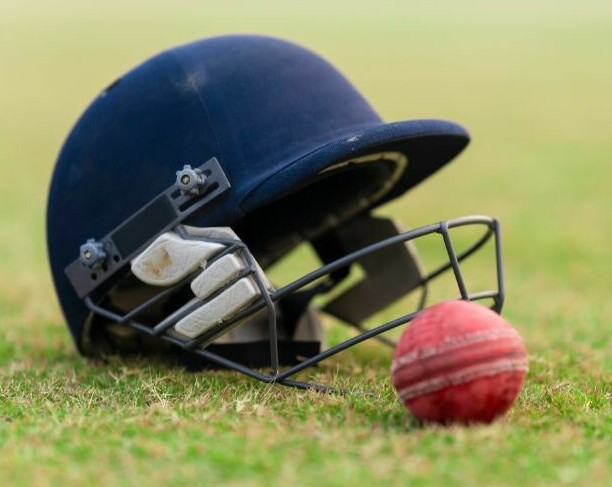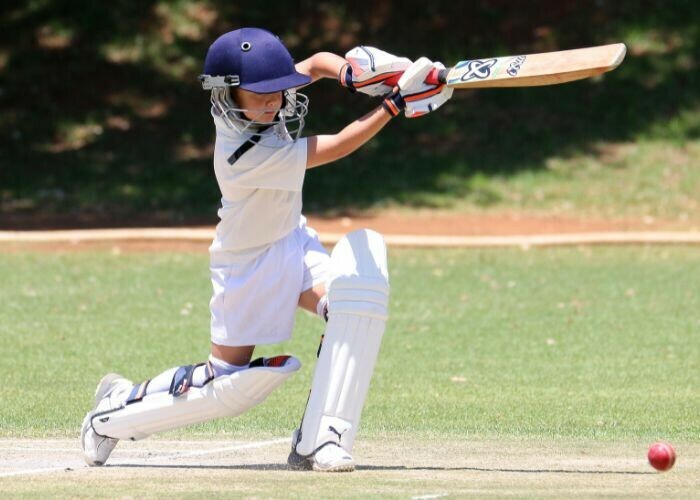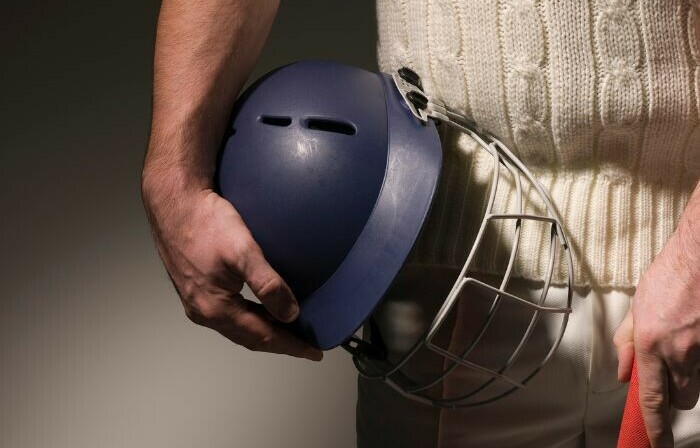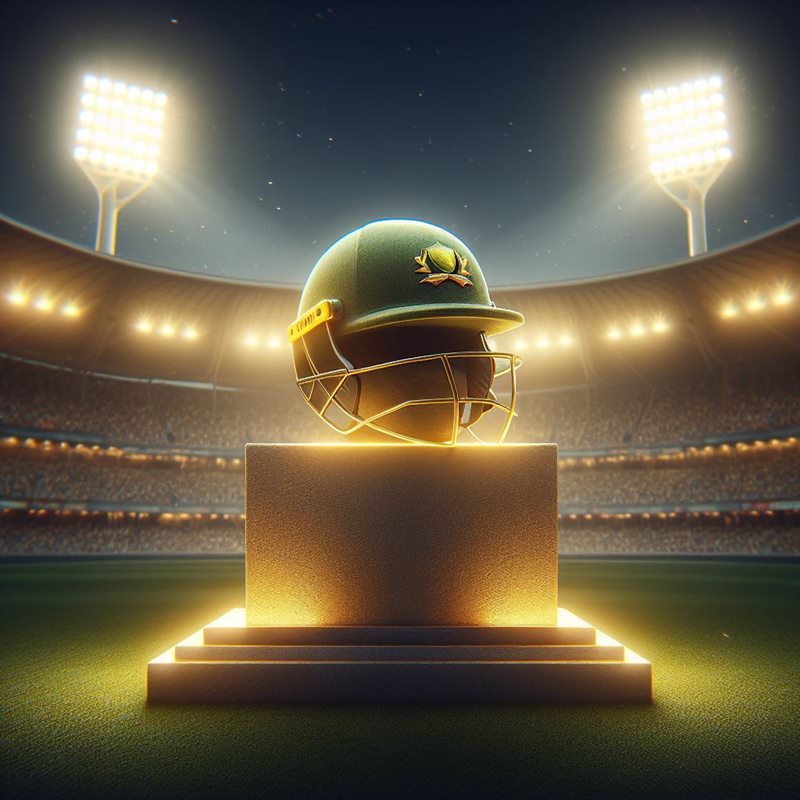We are continuing our series on selecting the correctly sized cricket gear, whether young or old. We’ve looked at cricket bat size and weight, and also cricket pads. We now go a little further up the body – all the way up, in fact – and look at cricket helmets.
Imagine, as a batsman, facing a fast bowler. A really fast bowler. The cricket ball, a solid sphere of hard leather, is hurtling your way at high speed. In such moments, a cricket helmet is the only line of defence protecting your head from serious injury.
However, a helmet that doesn’t fit correctly can compromise that safety, potentially leading to severe consequences.
Beyond safety, a helmet’s fit can also affect performance. If the helmet is too tight, it could be so uncomfortable it might distract the batter. One that is too lose could easily slip down over the batter’s eyes obstructing their vision, or fall off at just the wrong time, jeopardizing focus, response time, and, of course, the batter’s safety. A helmet’s optimal protection is compromised if the helmet can not stay snug and secure in all situations.
A cricket helmet is not a magical protection device. Even with a helmet on, tragedy can befall a batter. In 2014, Phil Hughes was killed when a ball hit him in the back of the neck, just below the protection of the helmet he was wearing. But without a helmet, many more would have met a similar fate over the years, so it is essential that the helmet you choose is able to protect you to the best of its capability.
Mastering Cricket Helmet Sizing: A Step-by-Step Guide

Getting the correct size of your cricket helmet is as vital as the helmet itself. A helmet that fits your head snuggly, without being uncomfortable or causing you pain, can better protect your head by absorbing the impact of a cricket ball.
Here’s how you can best measure your head to determine the best cricket helmet size for you.
You’ll first need a measuring tape. Place it about 1 centimetre about your eyebrows and wrap it around your head. You want to get the fullest part of your cranium to get a proper reading. Make sure the tape stays at the same level from front to back, and all the way around, otherwise the measurement is invalid.
This measurement is your head circumference, and it’s what we’ll use to determine your helmet size.
Knowing your head circumference, you’ll need to go to the helmet manufacturer of your preference. They should have a size chart that you can use to determine what size helmet is best for you. Compare the helmet size with your head measurement.
Please note that if you are checking multiple helmet manufactures, you will need to consult the manufacturer’s chart each time, as sizing can vary a little between different brands.
With the helmet, what you are looking for is a snug fit. It shouldn’t be too tight, which may cause you headaches and discomfort. But it shouldn’t also be so large that it can slip over your eyes, making it difficult for you to see the cricket ball coming your way, nor should it move around when you move. It should be a snug fit that doesn’t press too hard on any part of your head and allows you a little bit of movement.
Helmets can also have adjustable features, which you might consider. These might be internal padding or a ratchet system at the back. Adjusting these allows you to get a finer fit because they allow your helmet to adapt to your individual head shape, giving you extra comfort and added safety and security.
The Evolution of Helmet Sizes: From Young Cricketers To Adults

When it comes to cricket helmets for you or your child, you need to realise that head protection needs to evolve as the player grows. A helmet that fit perfectly a season ago and provided the best protection for the player’s head then, may not fit the same way this season. An individual helmet doesn’t cater for a players growth spurt, and can cause pain and discomfit when previously it had been perfect.
In this section we’ll explore how to keep on top of helmet sizing while players transition from childhood to adulthood, ensuring that they are always safe and secure at the batting crease.
For the youngest of players, helmets are especially designed with lighter materials and smaller dimensions to suit their needs. A helmet that is too heavy can cause neck strain and change the way the batter stands at the crease as the batter has to compensate for the heavy helmet pushing their head down. For a young batter that is learning how to play the game, a heavy batting helmet can stunt their cricketing development. It’s always recommended to check officially recognized youth sizes to get the best starting point for a child’s helmet fitting.
Finding the right helmet for a teenager can be challenging due to their rapid and uneven growth spurts. Helmets should not be bought at a bigger size to allow the wearer to grow into them. A helmet should always be properly fitting, otherwise they are compromised, and a compromised helmet can’t protect the head as well as a helmet that fits perfectly.
Helmets for this age bracket range between junior and standard adult sizes. During this time period of a young cricket’s cricketing journey, the helmet should be checked at least once a season to ensure it still fits properly. Parents and coaches should make sure the helmet is still snug, but not overly tight. It is imperative that the helmet achieves the right fit around the player’s forehead and temple, regardless of the player’s age.
And let’s for a moment step back from sizing and speak on the helmet’s condition. The size of the helmet is important, of course, but so is the condition of the helmet. In international cricket, if the ball actually strikes the batter’s helmet, that helmet is replaced, as the structural integrity of the helmet might have been compromised. All cricketers, regardless of age, should regularly inspect their helmets for signs of wear and tear, and should you notice any structural weaknesses or damage, do not hesitate to replace them.
As cricketers continue to grow and develop, their equipment must keep pace. For adults, helmet sizes are fairly consistent, but a person’s individual head shape can affect the choice of model and brand. You should test different helmets to find out which one feels best and suits your needs.
Adult batters face faster bowling speeds, and this means the possibility of more aggressive ball impacts. It is imperative that you prioritize helmets that pass the latest safety certifications and feature advanced protection features, like reinforced guards and increased shock absorption.
If you follow these guidelines, players will ensure they are equipped with helmets that fit them perfectly and provide the best level safety and protection to allow them to play with confidence; to focus on their game, rather than their gear.
Time for a Change: When and How To Upgrade Your Cricket Helmet

A cricket helmet is more than a piece of equipment; it’s a critical safeguard for every player. Knowing and recognizing when to invest in a new helmet is just as important as the initial purchase.
One of the first things to remember is that helmets have an expiration date; regardless of obvious signs of wear and tear, this expiration date is approximately 3 to 5 years from the date of manufacture. This is because the materials used in helmet construction degrade over time, and for something as important as your safety from cricket balls to the head, even a little degradation is a reason to consider changing helmets.
As said before, make it a routine to inspect the helmet before the season starts. Check for dents, cracks or other wear and tear that may affect the helmet’s integrity. If you find any, that just might be your cue to replace it.
Maintenance can play a big part in extending the life of your helmet. You should clean it regularly following the manufacturer’s instructions. But even with a rigorous maintenance schedule, once a helmet has served its time, it should be replaced as a matter of priority.
And since advancements in technology will likely mean that newer helmets will offer better protection and comfort, transitioning to a newer model offers many benefits.
But at the end of the day, keep in mind that your helmet is there to protect your head from injury, or worse. You should never compromise on safety. If you are ever in doubt about the condition of your helmet, you should always err on the side of caution and consider an upgrade.
Thank you for staying with me to the end of this article. We’ll next be talking about batting gloves and how to find the best batting gloves for you. As ever, if you have any interesting stories relating to today’s post, post them in the comment box below.

